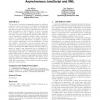707 search results - page 38 / 142 » A Practical Method for Quickly Evaluating Program Optimizati... |
CEC
2005
IEEE
13 years 9 months ago
2005
IEEE
The dynamics of neural and other automata networks are defined to a large extent by their topologies. Artificial evolution constitutes a practical means by which an optimal topolog...
ICCD
2007
IEEE
14 years 4 months ago
2007
IEEE
The deployment of future deep submicron technology calls for a careful review of existing cache organizations and design practices in terms of yield and performance. This paper pr...
TCBB
2008
13 years 7 months ago
2008
Reconstruction of phylogenetic trees is a fundamental problem in computational biology. While excellent heuristic methods are available for many variants of this problem, new adva...
GECCO
2007
Springer
14 years 1 months ago
2007
Springer
The success of a genetic programming system in solving a problem is often a function of the available computational resources. For many problems, the larger the population size an...
GECCO
2008
Springer
13 years 8 months ago
2008
Springer
The parsimony pressure method is perhaps the simplest and most frequently used method to control bloat in genetic programming. In this paper we first reconsider the size evolutio...

